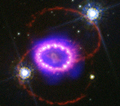Speaker
Patrick Slane
(Harvard-Smithsonian Center for Astrophysics)
Description
As a pulsar wind nebula evolves inside its host supernova remnant, its gamma-ray
emission becomes increasingly brighter due to the buildup of energetic particles
injected by its pulsar. When the SNR reverse shock collides with the PWN, the
resulting increase in the magnetic field results in rapid synchrotron losses,
modifying the particle spectrum of the nebula. Gamma-ray observations of composite
SNRs thus provide a probe of the underlying particle spectra that can be compared
with models for the evolution of these systems. In addition, particles accelerated
at the forward shock can produce gamma-ray emission through inverse Compton
scattering or the decay of pions from proton-proton collisions either within the SNR
shell or with dense material in surrounding molecular clouds. Here I report on
recent gamma-ray studies of several composite SNRs, and discuss the implications of
the gamma-ray results in the context of models of their broadband spectra.
Primary author
Patrick Slane
(Harvard-Smithsonian Center for Astrophysics)

